Page 40 of 343
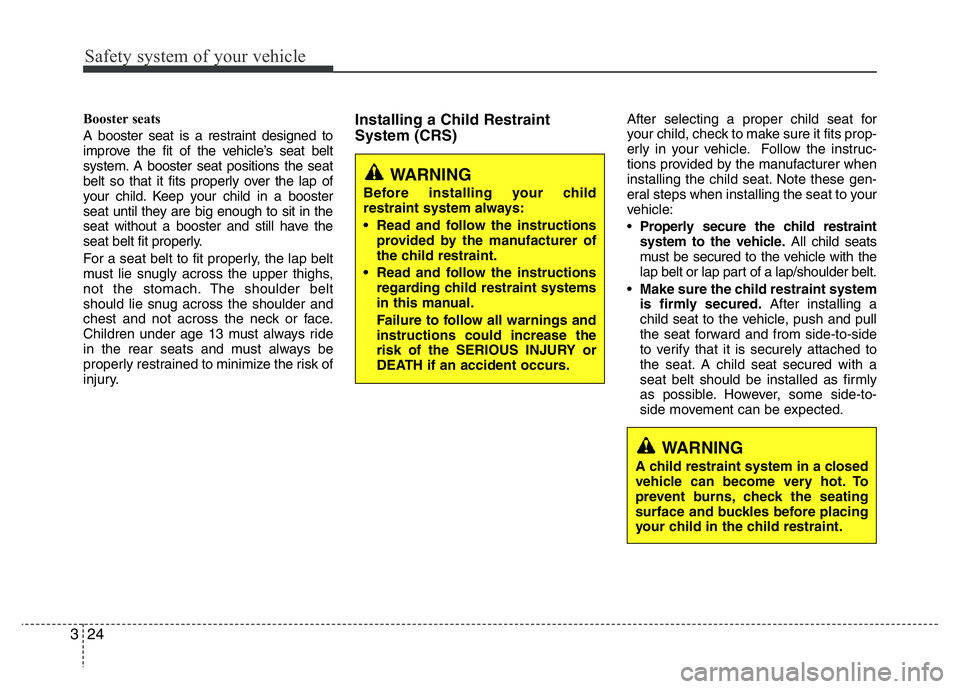
Safety system of your vehicle
24 3
Booster seats
A booster seat is a restraint designed to
improve the fit of the vehicle’s seat belt
system. A booster seat positions the seat
belt so that it fits properly over the lap of
your child. Keep your child in a booster
seat until they are big enough to sit in the
seat without a booster and still have the
seat belt fit properly.
For a seat belt to fit properly, the lap belt
must lie snugly across the upper thighs,
not the stomach. The shoulder belt
should lie snug across the shoulder and
chest and not across the neck or face.
Children under age 13 must always ride
in the rear seats and must always be
properly restrained to minimize the risk of
injury.Installing a Child Restraint
System (CRS) After selecting a proper child seat for
your child, check to make sure it fits prop-
erly in your vehicle. Follow the instruc-
tions provided by the manufacturer when
installing the child seat. Note these gen-
eral steps when installing the seat to your
vehicle:
•Properly secure the child restraint
system to the vehicle.All child seats
must be secured to the vehicle with the
lap belt or lap part of a lap/shoulder belt.
•Make sure the child restraint system
is firmly secured.After installing a
child seat to the vehicle, push and pull
the seat forward and from side-to-side
to verify that it is securely attached to
the seat. A child seatsecured with a
seat belt should be installed as firmly
as possible. However, some side-to-
side movement can be expected.
WARNING
Before installing your child
restraint system always:
• Read and follow the instructions
provided by the manufacturer of
the child restraint.
• Read and follow the instructions
regarding child restraint systems
in this manual.
Failure to follow all warnings and
instructions could increase the
risk of the SERIOUS INJURY or
DEATH if an accident occurs.
WARNING
A child restraint system in a closed
vehicle can become very hot. To
prevent burns, check the seating
surface and buckles before placing
your child in the child restraint.
Page 41 of 343
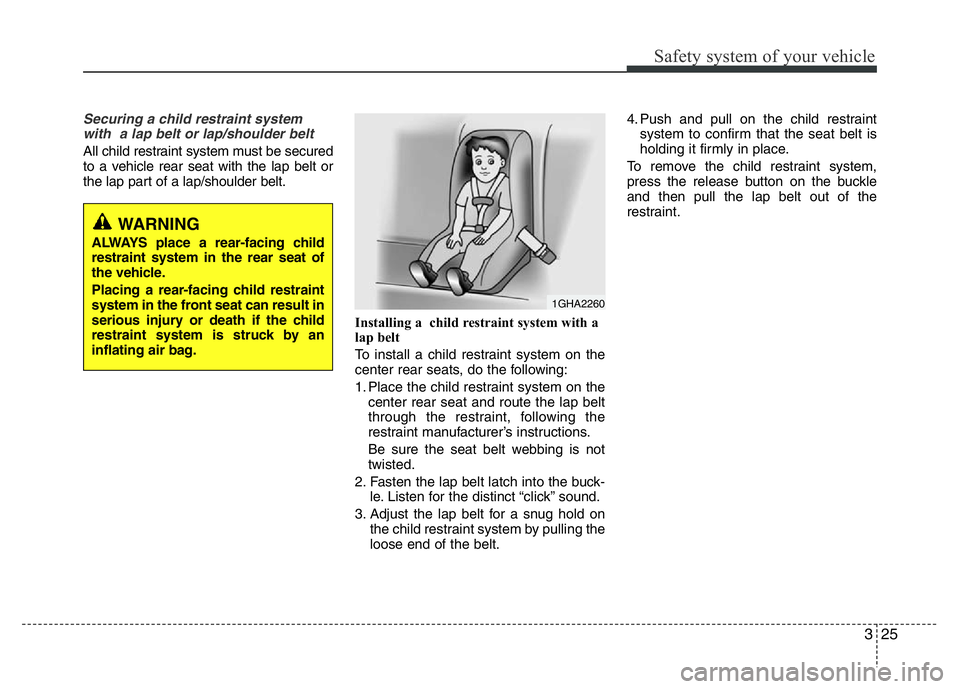
325
Safety system of your vehicle
Securing a child restraint system
with a lap belt or lap/shoulder belt
All child restraint system must be secured
to a vehicle rear seat with the lap belt or
the lap part of a lap/shoulder belt.
Installing a child restraint system with a
lap belt
To install a child restraint system on the
center rear seats, do the following:
1. Place the child restraint system on the
center rear seat and route the lap belt
through the restraint, following the
restraint manufacturer’s instructions.
Be sure the seat belt webbing is not
twisted.
2. Fasten the lap belt latch into the buck-
le. Listen for the distinct “click” sound.
3. Adjust the lap belt for a snug hold on
the child restraint system by pulling the
loose end of the belt.4. Push and pull on the child restraint
system to confirm that the seat belt is
holding it firmly in place.
To remove the child restraint system,
press the release button on the buckle
and then pull the lap belt out of the
restraint.
WARNING
ALWAYS place a rear-facing child
restraint system in the rear seat of
the vehicle.
Placing a rear-facing child restraint
system in the front seat can result in
serious injury or death if the child
restraint system is struck by an
inflating air bag.
1GHA2260
Page 42 of 343
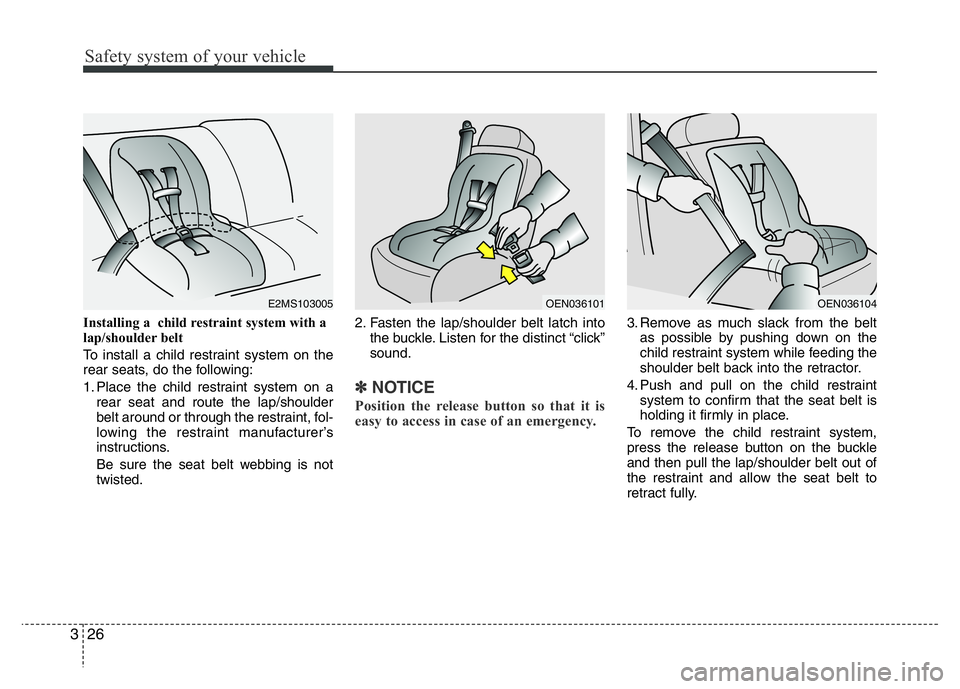
Safety system of your vehicle
26 3
Installing a child restraint system with a
lap/shoulder belt
To install a child restraint system on the
rear seats, do the following:
1. Place the child restraint system on a
rear seat and route the lap/shoulder
belt around or through the restraint, fol-
lowing the restraint manufacturer’s
instructions.
Be sure the seat belt webbing is not
twisted.2. Fasten the lap/shoulder belt latch into
the buckle. Listen for the distinct “click”
sound.
✽NOTICE
Position the release button so that it is
easy to access in case of an emergency.
3. Remove as much slack from the belt
as possible by pushing down on the
child restraint system while feeding the
shoulder belt back into the retractor.
4. Push and pull on the child restraint
system to confirm that the seat belt is
holding it firmly in place.
To remove the child restraint system,
press the release button on the buckle
and then pull the lap/shoulder belt out of
the restraint and allow the seat belt to
retract fully.
OEN036104E2MS103005OEN036101
Page 43 of 343
327
Safety system of your vehicle
(1) Driver’s front air bag*
(2) Passenger’s front air bag *
(3) Front passenger’s air bag ON/OFF
switch *
* : if equipped
AIR BAG - SUPPLEMENTAL RESTRAINT SYSTEM
WARNING
Even in vehicles with air bags, you
and your passengers must always
wear the safety belts provided in
order to minimize the risk and
severity of injury in the event of a
collision or rollover.
OBA033017/OBA033032
❈The actual air bags in the vehicle may differ from the illustration.
■Left-hand drive
3 3
Page 44 of 343
Safety system of your vehicle
28 3
(1) Driver’s front air bag*
(2) Passenger’s front air bag *
(3) Front passenger’s air bag ON/OFF
switch *
* : if equipped
WARNING
Even in vehicles with air bags, you
and your passengers must always
wear the safety belts provided in
order to minimize the risk and
severity of injury in the event of a
collision or rollover.
❈The actual air bags in the vehicle may differ from the illustration.
■Right-hand drive
OBA033017R/OBA033032R
3 3
Page 45 of 343
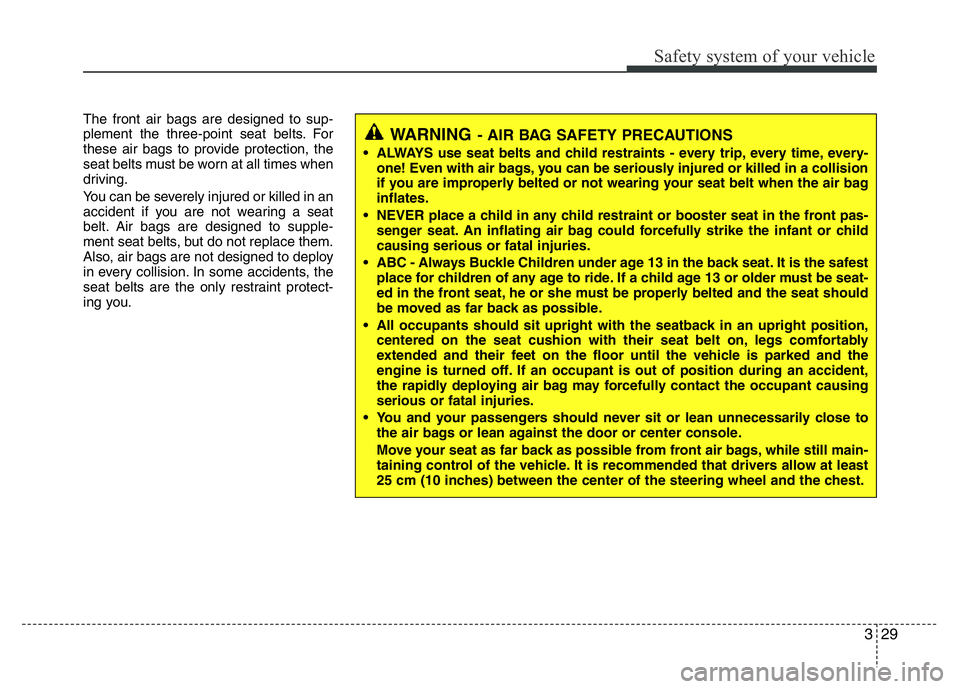
329
Safety system of your vehicle
The front air bags are designed to sup-
plement the three-point seat belts. For
these air bags to provide protection, the
seat belts must be worn at all times when
driving.
You can be severely injured or killed in an
accident if you are not wearing a seat
belt. Air bags are designed to supple-
ment seat belts, but do not replace them.
Also, air bags are not designed to deploy
in every collision. In some accidents, the
seat belts are the only restraint protect-
ing you.
WARNING- AIR BAG SAFETY PRECAUTIONS
• ALWAYS use seat belts and child restraints - every trip, every time, every-
one! Even with air bags, you can be seriously injured or killed in a collision
if you are improperly belted or not wearing your seat belt when the air bag
inflates.
• NEVER place a child in any child restraint or booster seat in the front pas-
senger seat. An inflating air bag could forcefully strike the infant or child
causing serious or fatal injuries.
• ABC - Always Buckle Children under age 13 in the back seat. It is the safest
place for children of any age to ride. If a child age 13 or older must be seat-
ed in the front seat, he or she must be properly belted and the seat should
be moved as far back as possible.
• All occupants should sit upright with the seatback in an upright position,
centered on the seat cushion with their seat belt on, legs comfortably
extended and their feet on the floor until the vehicle is parked and the
engine is turned off. If an occupant is out of position during an accident,
the rapidly deploying air bag may forcefully contact the occupant causing
serious or fatal injuries.
• You and your passengers should never sit or lean unnecessarily close to
the air bags or lean against the door or center console.
Move your seat as far back as possible from front air bags, while still main-
taining control of the vehicle. It is recommended that drivers allow at least
25 cm (10 inches) between the center of the steering wheel and the chest.
Page 46 of 343
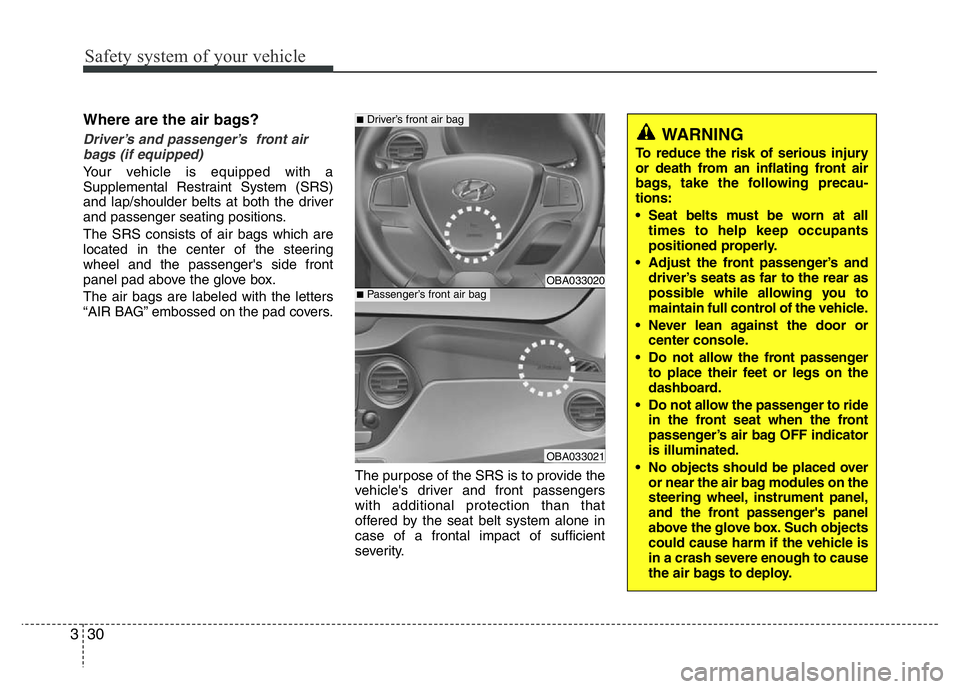
Safety system of your vehicle
30 3
Where are the air bags?
Driver’s and passenger’s front air
bags (if equipped)
Your vehicle is equipped with a
Supplemental Restraint System (SRS)
and lap/shoulder belts at both the driver
and passenger seating positions.
The SRS consists of air bags which are
located in the center of the steering
wheel and the passenger's side front
panel pad above the glove box.
The air bags are labeled with the letters
“AIR BAG” embossed on the pad covers.
The purpose of the SRS is to provide the
vehicle's driver and front passengers
with additional protection than that
offered by the seat belt system alone in
case of a frontal impact of sufficient
severity.
WARNING
To reduce the risk of serious injury
or death from an inflating front air
bags, take the following precau-
tions:
• Seat belts must be worn at all
times to help keep occupants
positioned properly.
• Adjust the front passenger’s and
driver’s seats as far to the rear as
possible while allowing you to
maintain full control of the vehicle.
• Never lean against the door or
center console.
• Do not allow the front passenger
to place their feet or legs on the
dashboard.
• Do not allow the passenger to ride
in the front seat when the front
passenger’s air bag OFF indicator
is illuminated.
• No objects should be placed over
or near the air bag modules on the
steering wheel, instrument panel,
and the front passenger's panel
above the glove box. Such objects
could cause harm if the vehicle is
in a crash severe enough to cause
the air bags to deploy.
OBA033020
OBA033021
■Driver’s front air bag
■Passenger’s front air bag
Page 47 of 343
331
Safety system of your vehicle
OBA033013R\ OBA033013\ ■
Left-hand drive■Right-hand drive
How does the air bags system operate?
The SRS consists of the following components:
1. Driver's front air bag module*
2. Passenger's front air bag module*
3. Pre-tensioner seatbelt system*
4. Air bag warning light*
5. SRS control module (SRSCM)*
6. Front impact sensors*7. Passenger’s front air bag ON/OFF indicator *
8. Passenger’s front air bag ON/OFF switch*
*: if equipped
The SRSCM continually monitors all SRS components while
the ignition switch is ON to determine if a crash impact is
severe enough to require air bag deployment or pre-tensioner
seat belt deployment.